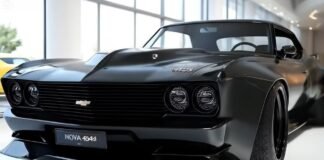When you think of muscle cars, images of roaring V8 engines and smoke-filled drag strips likely come to mind. So, what happens when Dodge, the poster child of old-school American muscle, decides to go fully electric? Meet the 2025 Dodge Charger Daytona EV, a car that boldly attempts to marry electrification with the raw essence of muscle cars.

First Impressions: An Electric Growl
Yes, that’s an electric car you’re hearing. The Charger Daytona makes an audacious statement with its Fratzonic Chambered Exhaust – a clever combination of subwoofers and speakers that produce a simulated exhaust note, rocking the car slightly to mimic the visceral rumble of a traditional V8.
It’s a unique feature that has divided opinions: is it a brilliant homage or a touch of over-the-top theatrics? Either way, it’s a striking start to Dodge’s electric revolution.
The Specs: Muscle Car DNA Reimagined

Underneath its futuristic body, the Charger Daytona packs serious performance credentials. This Scat Pack Stage 2 model boasts dual electric motors delivering a combined 670 horsepower and 627 lb-ft of torque. A limited-slip differential at the rear ensures better launches, while a 100 kWh battery offers consistent discharge rates for optimal performance.
For drag racing enthusiasts, Dodge introduces “Race Prep” mode, conditioning the battery to ensure multiple consistent 10.5-second quarter-mile runs.
It’s a nod to Dodge’s muscle car roots, proving that electrification doesn’t mean compromising on adrenaline-pumping thrills.
Design: A Modern Yet Familiar Look
From a distance, the Charger Daytona’s silhouette is unmistakably Dodge. It’s a modern take on the classic Charger design, featuring sleek lines and a futuristic touch. Signature elements like the illuminated “Fratzog” logos and an optional panoramic sunroof add to its unique character.
Inside, the car feels contemporary with a driver-centric layout. Large screens, a head-up display, and a tactile pistol-grip gear lever provide a tech-forward yet familiar vibe. There’s also a quirky “attitude adjustment” lighting system that changes based on the car’s mode, from sporty to subdued.
Driving Dynamics: Does It Deliver?

With a 0-60 mph time of 3.3 seconds, the Charger Daytona EV is faster than its Hellcat predecessor. However, the experience is notably different. Electric acceleration is smooth and linear, lacking the raw, chaotic drama of a gasoline engine. On the road, the Charger is comfortable and poised, with adaptive suspension systems that tighten up in performance modes.
Yet, when pushed to its limits, the car’s significant weight becomes apparent. The hefty 100 kWh battery adds considerable mass, making the Daytona feel less agile compared to traditional muscle cars. While it’s a competent cruiser, it struggles to evoke the rebellious spirit Dodge fans expect.
Practicality: More Than Just Performance

Unlike many sports cars, the Charger Daytona excels in practicality. Its spacious interior comfortably accommodates passengers, while folding rear seats and a hidden hatchback design provide plenty of cargo space. Features like wireless charging, Apple CarPlay, and Android Auto ensure it’s well-equipped for modern needs.
With an EPA-estimated range of 241 miles and fast-charging capability (20-80% in about 27 minutes), the Charger Daytona strikes a reasonable balance between performance and usability.
The Verdict: A Brave New Era
The 2025 Dodge Charger Daytona EV is an ambitious step into the future of muscle cars. It successfully redefines what a performance vehicle can be in the electric age, offering impressive speed, clever design features, and undeniable Dodge DNA.
That said, it’s not without its compromises. While it excels as a fast cruiser, its heft and lack of visceral engagement may leave some purists longing for the rawness of a traditional V8.
As Dodge transitions into this new era, the Charger Daytona EV sets an exciting precedent. Whether you view it as a bold reinvention or a departure from tradition, one thing is certain: the future of muscle cars is electric, and Dodge is leading the charge.


